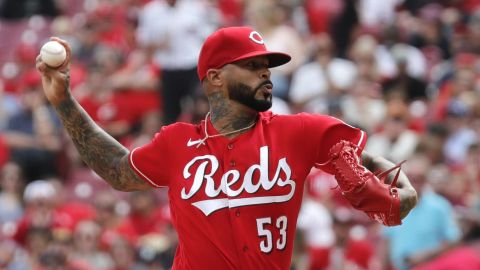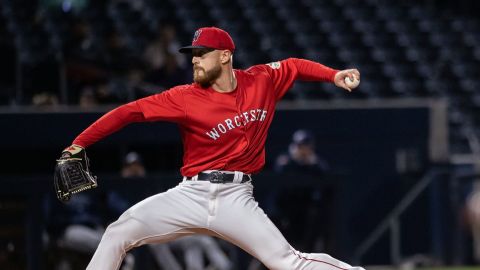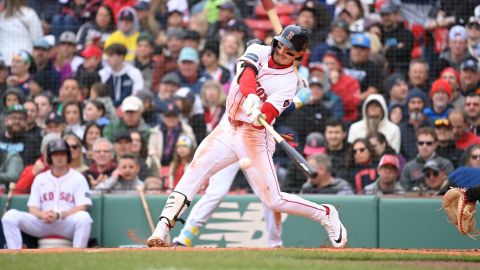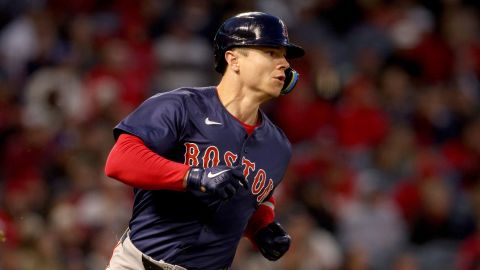 In my mind, Clay Buchholz has been an ace since 2012.
In my mind, Clay Buchholz has been an ace since 2012.
I began working for NESN right around June 1, 2012, and shortly thereafter began regularly live blogging Red Sox games for the duration of the season. So while Buchholz’s numbers on the season — 4.56 ERA, 1.33 WHIP — look pretty middling, in June and July he posted ERAs of 2.40 and 2.45, respectively, and after a 3.72 August put up a 3.03 mark in September. In any of those months, his highest opponents’ batting average against was .224.
In other words, I basically missed an April and May in which his ERAs were 8.69 and 5.60, so the 28-year-old right-hander’s incredible start to 2013 isn’t necessarily much of a surprise. Buchholz’s transition to staff ace was a process that began last year, with a confidence that’s clearly carried over the winter.
All that being said, as good as Buchholz was after May last year, he’s been downright dominant in his first six start this season.
The obvious questions then become: What Buchholz has changed to become so good, and what adjustments has he made? When he first came up through the Red Sox system, Buchholz’s pure stuff was raved about as much as any prospect ever, so we know he’s always had the ability to perform at this kind of level. His 2010 campaign did show flashes of brilliance, but by all accounts, just for the sake of being cliche, he’s taken his game to a whole new level in 2013.
As NESN.com MLB writer Ricky Doyle noted after Buchholz’s Wednesday night, seven-inning, six-hit effort, the right-hander’s strikeout rate has spiked so far this year. After having a strikeout rate just above six per nine innings from 2010 through 2012, Buchholz has struck out 47 in 44 2/3 innings in 2013, which is certainly one part of his surge.
However, diving a bit further into the numbers, it isn’t just that Buchholz is striking out more hitters, it’s how he’s doing it that’s so intriguing and the best indication of just how dominant he’s been.
To sum up the next several hundred words: Buchholz is getting hitters to look at called strikes at an incredible rate. Buchholz has recorded 25 strikeouts on called third strikes, good for best in the league. Moreover, his percentage of looking strikes has spiked about 10 percent from his career norms, and his looking-strikeout rate has increased 17 percent over 2012, which was already about 10 percent higher than his career average.
While he averaged about 26 to 28 percent looking strikes throughout his career, that number has jumped to 37 percent this year. After getting between 24 and 28 percent of his strikeouts on called pitches before 2012, last year he got 36 percent of his strikeouts with the hitter napping, and this year that’s spiked to 53 percent.
Now that we know how Buchholz has recorded his increased number of strikeouts, the questions then become how he is doing it and whether or not it is sustainable. The answer to these questions is decidedly less sabermetric, and has a lot to do with Buchholz’s command of his pitches.
One of the interesting things about Buchholz is that his general game plan hasn’t changed much over the years. Throughout his career he’s basically been a pitcher who throws his fastballs about 50 percent of the time. He throws his lauded changeup about 10 percent less than he did during his first three seasons in the big leagues, and his former slider has now become more of a cutter. But those are really the only significant changes in how Buchholz deploys his repertoire.
Rather, Buchholz’s newfound dominance is simply in his ability to locate his pitches better as he’s aged — which is just about the oldest pitcher’s story in baseball. His two-seam fastball, in particular, has always had incredible lateral movement, and it’s the use of that lateral break that’s made him so effective.
Take Wednesday night’s game as an example. Of the 66 strikes that Buchholz recorded, just nine were swinging, with 28 being called looking. Likewise, four of his strikeouts were recorded looking, continuing Buchholz’s season-long trend.
Take this video — which features all four of his caught-looking strikeouts on Wednesday — for perfect examples of Buchholz’s ability to move his two-seam fastball across the zone. While his first looking strikeout comes on the curveball, each of the next three are the same. Brett Lawrie, Jose Bautista and J.P. Arencibia, all right-handed hitters, are unable to react to Buchholz’s two-seamer, which starts off the outside corner of the plate before moving back into the zone. The fact that the pitches move so far toward the inner half shows just how nasty the movement on them is.
In short, nothing about Buchholz’s stuff has changed — he’s always had the ability to do this. But command has been the key for him, as he’s learned how to wield a particular weapon — his two-seam fastball — to maximum results. But it’s because that fastball has so much lateral movment that Buchholz has the ability to deploy it how he has this season, and what gives him an edge on the competition.



